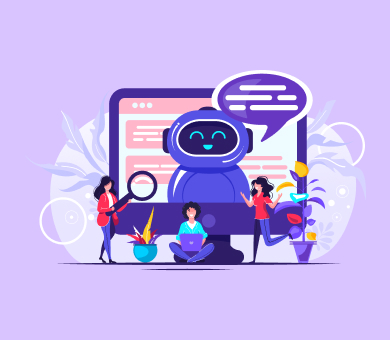Enhance Your AI Chat Assistant’s Performance

As AI keeps getting better, so do AI chatbots. One way to make them even more effective is by fine-tuning them with methods like Low-Rank Adaptation (LoRA).
This article looks at how LoRA can boost your AI chat assistant’s performance and make it more flexible.
Understanding LLMs (Large Language Models)
Large Language Models like GPT-4 and BERT are smart AI systems trained on tons of text.
They understand and create human-like text, which makes them useful for completing sentences, translating languages, and chatting with users.
However, they can sometimes be too generic and might not be as good at handling specific, specialized tasks without some extra tweaking.
What Is LoRA (Low-Rank Adaptation)?
Low-rank adaptation is a way to tweak large language models to do specific tasks without using up a lot of computing power. Instead of retraining the whole model, LoRA adds some extra, smaller adjustments to the model’s layers.
Benefits of Using LoRA for AI Chat Assistants
LoRA can make a big difference in how well your AI tools perform. The great thing about LoRA is that it doesn’t need a lot of computing power. It’s efficient and cost-effective, meaning you can update and improve your assistant without breaking the bank.

Another standout benefit of LoRA is how it lets you customize your LLM. Instead of using a generic model, you can customize it to handle specific tasks or areas.
This means your assistant can provide more relevant and useful responses.
LoRA also helps reduce the amount of resources needed. Traditional fine-tuning methods can be a heavy lift, but with LoRA, you only adjust a small part of the model.
How to Use LoRA with Your AI Chat Assistant
Adding LoRA to AI chat assistants can boost their performance and make them fit any needs. Here’s a simple guide to help you get started:
1. Set Your Goals
Start by spotting what you want your AI chat assistant to do better. Are you aiming to improve how it handles certain types of questions or make it more knowledgeable in specific areas? Having clear goals will make the rest of the process easier.
2. Gather and Prep Your Data
Next, collect data that goes in line with your goals. This could be conversation examples, specialized terms, or content related to your field. Once you get the data, clean it up and format it so it’s ready for training.
3. Set Up LoRA
Now, you’ll need to add LoRA to your LLM. This step involves introducing low-rank matrices, which help tweak the model without needing a complete overhaul. Set up LoRA according to the instructions for your specific AI model.
4. Fine-Tune the Model
With LoRA setup, you’ll fine-tune your model using your prepared data. This means training the low-rank matrices so they can adapt the model’s responses to be more in line with your goals.
5. Test and Review
After fine-tuning, test how well your AI chat assistant performs with real or mock conversations. Check if it meets your goals and make any necessary tweaks. You might need to adjust the LoRA settings or do some more training based on what you find.
6. Deploy and Monitor
Once you’re happy with the results, deploy the updated model. Watch how it performs in real situations and gather feedback from users. Be ready to make more alterations based on this feedback.
7. Keep Improving
One of the most amazing things about LoRA is that it allows for ongoing tweaks. Use user feedback and changing needs to keep refining your AI chat assistant.
Case Studies and Examples
Now, let’s have a look at some big names that have already used LoRA to make their AI chat assistants better:

Sephora
Sephora, the popular beauty retailer, used LoRA to reinforce their AI chat assistant, Sephora Virtual Artist.
By tuning it to better handle beauty-related questions and give personalized product suggestions, Sephora made their customer support much more helpful.
Shoppers got tailored advice on makeup and skincare, which led to happier customers and more engagement.
Babylon Health
Babylon Health, known for its digital health services, applied LoRA to improve its AI chat assistant.
They focused on making it better at understanding medical terms and patient questions, as well as capable of providing recommendations to people seeking medical information, which boosted the quality of their virtual health consultations.
Duolingo
Duolingo, a top language learning app, used LoRA to fine-tune their AI chat assistant to help with language practice. The tweaks allowed the assistant to better handle common learning challenges and offer more personalized help.
Challenges and Considerations
Using LoRA to improve AI chat assistants is pretty good, but there are some things to watch out for.
The quality of the data you use is really important—if it’s not accurate or representative, LoRA might not work as well. Plus, LoRA can’t fix major issues with the base model itself, and setting it up can be a bit tricky, requiring the right know-how.
Also, while LoRA helps prevent overfitting, there’s still a risk that the model might get too specialized. You shouldn’t give up LLM development to make sure it stays effective.
Future of LoRA and AI Chat Assistants
As AI tech keeps moving forward, LoRA is set to become even more important for making language models more flexible and efficient. In the future, we might see improvements in how LoRA works, how easily it integrates with other systems, and how it’s used in different industries.
Conclusion
Low-rank adaptation is a great way to boost the performance of AI chat assistants with a more focused fine-tuning approach. Learning how to use LoRA can improve what your AI chat assistant can do, making it more useful for your specific needs.
Want to improve your AI chat assistant with advanced fine-tuning like LoRA? Reach out to SCAND now to see how our company can help you get the most out of AI.



